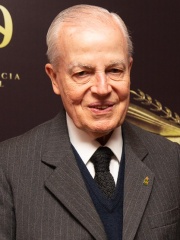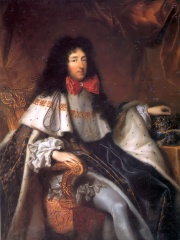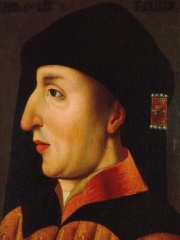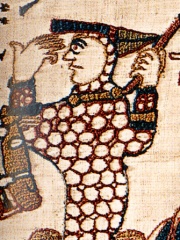
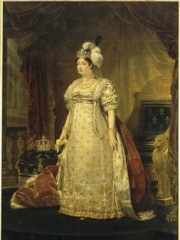

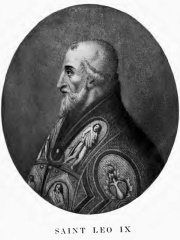

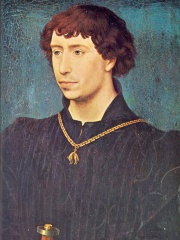
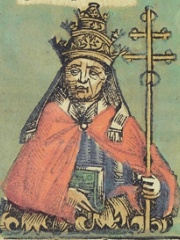
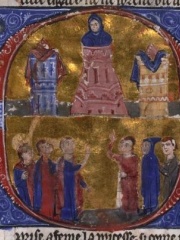
The Most Famous
NOBLEMEN from France
Top 10
The following people are considered by Pantheon to be the top 10 most legendary French Noblemen of all time. This list of famous French Noblemen is sorted by HPI (Historical Popularity Index), a metric that aggregates information on a biography's online popularity. Visit the rankings page to view the entire list of French Noblemen.

1. William the Conqueror (1028 - 1087)
With an HPI of 81.79, William the Conqueror is the most famous French Nobleman. His biography has been translated into 102 different languages on wikipedia.
William the Conqueror (c. 1028 – 9 September 1087), sometimes called William the Bastard, was the first Norman king of England (as William I), reigning from 1066 until his death. A descendant of Rollo, he was Duke of Normandy (as William II) from 1035 onward. By 1060, following a long struggle, his hold on Normandy was secure. In 1066, following the death of Edward the Confessor, William invaded England, leading a Franco-Norman army to victory over the Anglo-Saxon forces of Harold Godwinson at the Battle of Hastings, and suppressed subsequent English revolts in what has become known as the Norman Conquest. The rest of his life was marked by struggles to consolidate his hold over England and his continental lands, and by difficulties with his eldest son, Robert Curthose. William was the son of the unmarried Duke Robert I of Normandy and his mistress Herleva. His illegitimate status and youth caused some difficulties for him after he succeeded his father, as did the anarchy which plagued the first years of his rule. During his childhood and adolescence, members of the Norman aristocracy battled each other, both for control of the child duke, and for their own ends. In 1047, William quashed a rebellion and began to establish his authority over the duchy, a process that was not complete until about 1060. His marriage in the 1050s to Matilda of Flanders provided him with a powerful ally in the neighbouring county of Flanders. By the time of his marriage, William was able to arrange the appointment of his supporters as bishops and abbots in the Norman church. His consolidation of power allowed him to expand his horizons, and he secured control of the neighbouring county of Maine by 1062. In the 1050s and early 1060s, William became a contender for the throne of England held by the childless Edward the Confessor, his first cousin once removed. There were other potential claimants, including the powerful English earl Harold Godwinson, whom Edward named as king on his deathbed in January 1066. Arguing that Edward had previously promised the throne to him and that Harold had sworn to support his claim, William built a large fleet and invaded England in September 1066. He decisively defeated and killed Harold at the Battle of Hastings on 14 October 1066. After further military efforts, William was crowned king on Christmas Day, 1066, in London. He made arrangements for the governance of England in early 1067 before returning to Normandy. Several unsuccessful rebellions followed, but William's hold on England was mostly secure by 1075, allowing him to spend the greater part of his reign in continental Europe. William's final years were marked by difficulties in his continental domains, troubles with his son, Robert, and threatened invasions of England by the Danes. In 1086, he ordered the compilation of the Domesday Book, a survey listing all of the land-holdings in England along with their pre-Conquest and current holders. He died in September 1087 while leading a campaign in northern France, and was buried in Caen. His reign in England was marked by the construction of castles, settling a new Norman nobility on the land, and change in the composition of the English clergy. He did not try to integrate his domains into one empire but continued to administer each part separately. His lands were divided after his death: Normandy went to Robert, and England went to his second surviving son, William Rufus.

2. Marie Thérèse of France (1778 - 1851)
With an HPI of 80.59, Marie Thérèse of France is the 2nd most famous French Nobleman. Her biography has been translated into 44 different languages.
Marie-Thérèse (Marie-Thérèse Charlotte; 19 December 1778 – 19 October 1851) was the eldest child of King Louis XVI and Queen Marie Antoinette of France, and their only child to reach adulthood. In 1799, she married her cousin Louis Antoine, Duke of Angoulême, the eldest son of Charles X of France, henceforth becoming the Duchess of Angoulême. She became Dauphine of France upon the accession of her uncle and father-in-law, Charles X, to the French throne in 1824. On 2 August 1830, after the July Revolution, both Charles X and her husband signed an instrument of abdication 20 minutes apart. Some popular sources identify her to be a short-reigning Queen of France in the 20-minute interval between the signatures, but scholarly sources generally consider this to be a myth. She is, however, the undisputed legitimate Queen of France from 1836 to 1844 according to the Legitimists.

3. Eleanor of Aquitaine (1122 - 1204)
With an HPI of 80.28, Eleanor of Aquitaine is the 3rd most famous French Nobleman. Her biography has been translated into 62 different languages.
Eleanor of Aquitaine (French: Aliénor d'Aquitaine or Éléonore d'Aquitaine; Occitan: Alienòr d'Aquitània [aljeˈnɔɾ dakiˈtanjɔ]; Latin: Helienordis, Alienorde or Alianor; c. 1124 – 1 April 1204) was duchess of Aquitaine from 1137 to 1204, queen of France from 1137 to 1152 as the wife of King Louis VII, and queen of England from 1154 to 1189 as the wife of King Henry II. As the reigning duchess of Aquitaine, she ruled jointly with her husbands and two of her sons, Kings Richard I and John of England. As the heiress of the House of Poitiers, which controlled much of southwestern France, she was one of the wealthiest and most powerful people in Western Europe during the High Middle Ages. The eldest child of Duke William X of Aquitaine and Aénor de Châtellerault, Eleanor became duchess upon her father's death in 1137. Later that year, she married Louis, son of King Louis VI of France. Shortly afterwards, Eleanor's father-in-law died and her husband became king, making her queen consort. Louis VII and Eleanor had two daughters, Marie and Alix. During the Second Crusade, Eleanor accompanied Louis to the Holy Land. Pope Eugene III rejected an initial request in 1149 for an annulment of the marriage on grounds of consanguinity. In 1152, after fifteen years of marriage, Eleanor had not borne a male heir, and the annulment was granted. Their daughters were declared legitimate, custody was awarded to Louis, and Eleanor's lands were restored to her. In the same year, Eleanor married Henry, the duke of Normandy. In 1154, Henry and Eleanor became king and queen of England. The couple had five sons and three daughters, but eventually became estranged. Henry imprisoned Eleanor for supporting the 1173 revolt against him by their sons Young Henry, Richard and Geoffrey. She was not released until 1189, when Henry II died and Richard I ascended the throne. As queen dowager, Eleanor acted as regent during Richard's long absences from England and France. On Richard's death in 1199, she successfully campaigned for his younger brother John to succeed him. After continuing turmoil between the French and English kings and the successive loss of the lands she and Henry II had once ruled over, she died in 1204 and was buried in Fontevraud Abbey in France.

4. Pope Leo IX (1002 - 1054)
With an HPI of 79.87, Pope Leo IX is the 4th most famous French Nobleman. His biography has been translated into 70 different languages.
Pope Leo IX (Italian: Leone IX, German: Leo IX., 21 June 1002 – 19 April 1054), born Bruno von Egisheim-Dagsburg, was the head of the Catholic Church and ruler of the Papal States from 12 February 1049 to his death in 1054. Leo IX is considered to be one of the most historically significant popes of the Middle Ages; he was instrumental in the precipitation of the Great Schism of 1054, considered the turning point in which the Catholic and Eastern Orthodox Churches formally separated. Leo IX favoured traditional morality in his reformation of the Catholic Church. One of his first public acts was to hold the Easter synod of 1049; he joined Emperor Henry III in Saxony and accompanied him to Cologne and Aachen. He also summoned a meeting of the higher clergy in Reims, in which several important reforming decrees were passed. At Mainz, he held a council at which the Italian and French as well as the German clergy were represented, and ambassadors of the Byzantine emperor were present. Here too, simony and clerical marriage were the principal matters dealt with. He is regarded as a saint by the Catholic Church; his feast day is celebrated on 19 April.
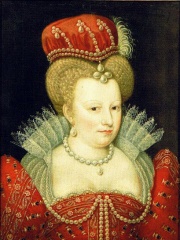
5. Margaret of Valois (1553 - 1615)
With an HPI of 79.67, Margaret of Valois is the 5th most famous French Nobleman. Her biography has been translated into 54 different languages.
Margaret of Valois (French: Marguerite, 14 May 1553 – 27 March 1615), popularly known as Queen Margot (La Reine Margot), was Queen of Navarre from 1572 to 1599 and Queen of France from 1589 to 1599 as the consort of Henry IV of France and III of Navarre. Margaret was the daughter of King Henry II of France and Catherine de' Medici and the sister of Kings Francis II, Charles IX and Henry III. Her union with Henry of Navarre, intended to contribute to the reconciliation of Catholics and Huguenots in France, was tarnished six days after the marriage ceremony by the St. Bartholomew's Day massacre and the resumption of the French Wars of Religion. In the conflict between Henry III of France and the Malcontents, she took the side of Francis, Duke of Anjou, her younger brother, which caused Henry to have a deep aversion towards her. As Queen of Navarre, Margaret also played a pacifying role in the stormy relations between her husband and the French monarchy. Shuttling back and forth between both courts, she endeavoured to lead a happy conjugal life, but her infertility and the political tensions inherent in the civil conflict led to the end of her marriage. Mistreated by her brother Henry, who was quick to take offence, and rejected by her husband, she chose the path of opposition in 1585. She took the side of the Catholic League and was thus exiled to Auvergne, which lasted for 20 years. In 1599, she consented to a "royal divorce", the annulment of the marriage, but only after the payment of a generous compensation. A well-known woman of letters, considered both enlightened and a generous patron, Margaret played a considerable part in the cultural life of the court, especially after her return from exile in 1605. She preached the supremacy of platonic love over physical love. During her imprisonment, she took advantage of the time to write her Memoirs, the first woman to have done so. One of the most fashionable women of her time, her dress influenced many of Europe's royal courts. After Margaret's death, the anecdotes and slanders circulated about her created a legend which consolidated around the nickname La Reine Margot, invented by Alexandre Dumas père. These fictional elements of nymphomania and incest created a mythical image of a woman which persisted through the centuries to the modern day. In the late 20th and the early 21st centuries, revisionist historians have reviewed the extensive chronicles of her life and concluded that some elements of her scandalous reputation stemmed from anti-Valois propaganda and a factionalism that denigrated the participation of women in politics and was created by Bourbon dynasty court historians in the 17th century.

6. Henrik, Prince Consort of Denmark (1934 - 2018)
With an HPI of 78.58, Henrik, Prince Consort of Denmark is the 6th most famous French Nobleman. His biography has been translated into 49 different languages.
Prince Henrik of Denmark (Danish pronunciation: [ˈhenˀʁek]; born Henri Marie Jean André de Laborde de Monpezat; 11 June 1934 – 13 February 2018) was the husband of Margrethe II of Denmark. He served as her royal consort from Margrethe's accession on 14 January 1972 until his death in 2018. Henrik was born in the French commune of Talence near Bordeaux to an old French family, the Laborde de Monpezats. He spent his early years in Tonkin in French Indochina (now part of Vietnam), where his family had lived for many years. The family spent the Second World War at the family home in Cahors, France. They returned to French Indochina after the war. However, they were forced to flee following the defeat of the French in the First Indochina War. After completing his education in France and Vietnam, Henrik served in the French Army during the Algerian War. Prior to his marriage to Margrethe, he worked in the diplomatic service. He married Margrethe at the Holmen Church on 10 June 1967 and became her prince consort when she succeeded her father, King Frederik IX, as monarch of Denmark on 14 January 1972. He had two sons, King Frederik X (born 1968) and Prince Joachim (born 1969), and eight grandchildren. Throughout his time as prince consort, Henrik voiced his displeasure with never being granted the title of king. A keen winemaker, Henrik produced his own wine at his estate in France. He also published many works of poetry. He was the first male consort to a Danish monarch. Henrik retired from his royal duties on 1 January 2016, at the age of 81. He died at Fredensborg Palace on 13 February 2018, after a short illness.

7. Charles the Bold (1433 - 1477)
With an HPI of 78.50, Charles the Bold is the 7th most famous French Nobleman. His biography has been translated into 62 different languages.
Charles Martin (10 November 1433 – 5 January 1477), called the Bold, was the last duke of Burgundy from the House of Valois-Burgundy, ruling from 1467 to 1477. He was the only surviving legitimate son of Philip the Good and his third wife, Isabella of Portugal. As heir and as ruler, Charles vied for power and influence with rivals such as his overlord, King Louis XI of France. In 1465, Charles led a successful revolt of Louis's vassals in the War of the Public Weal. After becoming the Duke of Burgundy in 1467, Charles pursued his ambitions for an independent kingdom which would stretch contiguously from the North Sea in the north to the borders of Savoy in the south. For this purpose, he acquired Guelders and Upper Alsace; sought the title King of the Romans; and gradually became an enemy of the Germans. Charles married Margaret of York for an English alliance. He arranged the betrothal of his only child, Mary, to Maximilian of Austria. A passionate musician and patron of the arts, Charles supported the production of illuminated manuscripts and music. His court was famously known as a centre of arts, chivalry, and etiquette. He was obsessed with order and regulation and issued many ordinances throughout his rule, dictating military matters, legislation, and diplomacy in the minutest detail. Charles was religious and his patron saint was Saint George. He turned down multiple requests from the pope and the Venetians to undertake a crusade against the Ottoman Turks. Towards the end of his life, Charles became engaged in a multi-national conflict called the Burgundian Wars (1474–1477), where he fought to retain ownership of Upper Alsace against an alliance of Swiss, German, and Alsatian polities called the Lower League. After his unsuccessful siege of Neuss, he was defeated by the Swiss at the battles of Grandson and Morat. Charles was killed during the Battle of Nancy on 5 January 1477, fighting against Duke René II of Lorraine and his Swiss army. His death triggered the War of the Burgundian Succession and led to the end of the Burgundian State. Charles's daughter, Mary, was the last of Charles's dynasty. Mary's son, Philip of Austria, inherited the Burgundian Netherlands.

8. Amadeus VIII, Duke of Savoy (1383 - 1451)
With an HPI of 76.68, Amadeus VIII, Duke of Savoy is the 8th most famous French Nobleman. His biography has been translated into 46 different languages.
Amadeus VIII (4 September 1383 – 7 January 1451), nicknamed the Peaceful, was Count of Savoy from 1391 to 1416 and Duke of Savoy from 1416 to 1440. He was the first to hold the ducal title, granted by Emperor Sigismund. Known for his diplomatic temperament and administrative reforms, he strengthened the state's institutions and fostered internal peace. He also claimed the papacy from 1439 to 1449 as Antipope Felix V, in opposition to Popes Eugene IV and Nicholas V, becoming the last historical antipope recognised by a significant portion of the Catholic clergy.

9. Raynald of Châtillon (1123 - 1187)
With an HPI of 76.28, Raynald of Châtillon is the 9th most famous French Nobleman. His biography has been translated into 35 different languages.
Raynald of Châtillon (c. 1124 – 4 July 1187), also known as Reynald, Reginald, or Renaud, was Prince of Antioch—a crusader state in the Middle East—from 1153 to 1160 or 1161, and Lord of Oultrejordain—a large fiefdom in the crusader Kingdom of Jerusalem—from 1175 until his death, ruling both territories iure uxoris ('by right of wife'). The second son of a French noble family, he joined the Second Crusade in 1147, and settled in Jerusalem as a mercenary. Six years later, he married Princess Constance of Antioch, although her subjects regarded the marriage as a mesalliance. Always in need of funds, Raynald tortured Aimery of Limoges, Latin Patriarch of Antioch, who had refused to pay a subsidy to him. He launched a plundering raid in Cyprus in 1156, causing great destruction in Byzantine territory. Four years later, Manuel I Komnenos, the Byzantine Emperor, led an army towards Antioch, forcing Raynald to accept Byzantine suzerainty. Raynald was raiding the valley of the river Euphrates in 1160 or 1161 when the governor of Aleppo captured him at Marash. He was released for a large ransom in 1176 but did not return to Antioch, because his wife had died in the interim. He married Stephanie of Milly, the wealthy heiress of Oultrejordain. Since King Baldwin IV of Jerusalem had also granted Hebron to him, Raynald became one of the wealthiest barons in the kingdom. After Baldwin, who suffered from leprosy, made him regent in 1177, Raynald led the crusader army that defeated Saladin, the Sultan of Egypt and Syria, at the Battle of Montgisard. In control of the caravan routes between Egypt and Syria, he was the only Christian leader to pursue an offensive policy against Saladin, by making plundering raids against the caravans travelling near his domains. After Raynald's newly constructed fleet plundered the coast of the Red Sea in early 1183, threatening the route of Muslim pilgrims to Mecca, Saladin pledged that he would never forgive him. Raynald was a firm supporter of Baldwin IV's sister, Sybilla, and her husband, Guy of Lusignan, during conflicts regarding Baldwin's succession. Sybilla and Guy were able to seize the throne in 1186 due to Raynald's co-operation with her uncle, Joscelin III of Courtenay. In spite of a truce between Saladin and the Kingdom of Jerusalem, Raynald attacked a caravan travelling from Egypt to Syria in late 1186 or early 1187, claiming that the truce was not binding upon him. After Raynald refused to pay compensation, Saladin invaded the kingdom and annihilated the crusader army in the Battle of Hattin. Raynald was captured on the battlefield. Saladin personally beheaded him after he refused to convert to Islam. Many historians have regarded Raynald as an irresponsible adventurer whose lust for booty caused the fall of the Kingdom of Jerusalem. On the other hand, the historian Bernard Hamilton says that he was the only crusader leader who tried to prevent Saladin from unifying the nearby Muslim states.
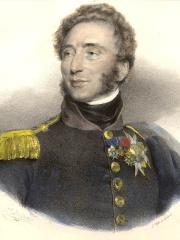
10. Louis Antoine, Duke of Angoulême (1775 - 1844)
With an HPI of 76.22, Louis Antoine, Duke of Angoulême is the 10th most famous French Nobleman. His biography has been translated into 48 different languages.
Louis Antoine of France, Duke of Angoulême (6 August 1775 – 3 June 1844) was the elder son of Charles X of France and the last Dauphin of France from 1824 to 1830. He was a petit-fils de France at birth, and was initially known as Louis Antoine d'Artois. After his father's accession to the throne, he became Dauphin de France, and his surname changed to de France, following the royal custom for princes with such rank.
People
Pantheon has 163 people classified as French noblemen born between 495 and 1963. Of these 163, 4 (2.45%) of them are still alive today. The most famous living French noblemen include Prince Lorenz of Belgium, Archduke of Austria-Este, Prince Sixtus Henry of Bourbon-Parma, and Bertrand of Orléans-Braganza. The most famous deceased French noblemen include William the Conqueror, Marie Thérèse of France, and Eleanor of Aquitaine.
Living French Noblemen
Go to all RankingsPrince Lorenz of Belgium, Archduke of Austria-Este
1955 - Present
HPI: 67.61
Prince Sixtus Henry of Bourbon-Parma
1940 - Present
HPI: 62.61
Bertrand of Orléans-Braganza
1941 - Present
HPI: 59.45
Prince Carlo, Duke of Castro
1963 - Present
HPI: 56.36
Deceased French Noblemen
Go to all RankingsWilliam the Conqueror
1028 - 1087
HPI: 81.79
Marie Thérèse of France
1778 - 1851
HPI: 80.59
Eleanor of Aquitaine
1122 - 1204
HPI: 80.28
Pope Leo IX
1002 - 1054
HPI: 79.87
Margaret of Valois
1553 - 1615
HPI: 79.67
Henrik, Prince Consort of Denmark
1934 - 2018
HPI: 78.58
Charles the Bold
1433 - 1477
HPI: 78.50
Amadeus VIII, Duke of Savoy
1383 - 1451
HPI: 76.68
Raynald of Châtillon
1123 - 1187
HPI: 76.28
Louis Antoine, Duke of Angoulême
1775 - 1844
HPI: 76.22
Philippe I, Duke of Orléans
1640 - 1701
HPI: 76.21
Philip the Bold
1342 - 1404
HPI: 75.54
Overlapping Lives
Which Noblemen were alive at the same time? This visualization shows the lifespans of the 25 most globally memorable Noblemen since 1700.



